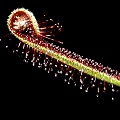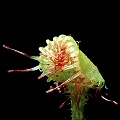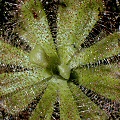Q: How can plants move? Are they really animals?

D. capensis with prey

D. rotundifolia
ready for action

D. rotundifolia
with food!

D. cuneifolia
A: All plants have some power of movement. It may be as simple as
the plant moving because it enlarges as it grows, or tracking the sun as it moves across the sky.
But with some carnivorous plants the motion can be
extremely fast and impressive. Since plants do not have muscle tissue, how do
they do it?
Carnivorous plants use three main movement mechanisms (although scientists still argue about this).
The first mechanism is what Venus flytraps use to snap their traps closed.
It involves changes in cell sizes by "acid growth." When the trap is activated (by touching trigger
hairs on the leaves), the outside surface of the trap becomes larger than the inside wall.
This snaps the leaf closed, similar to the way bimetallic
strips work in thermostats. (But for more complicated details, look here.)
The second kind of motion is powered by cell growth---the tentacles of
sundews bend towards prey because the cells on one side of the tentacles
outgrow the cells on the tentacle's other side. A third kind of effect might involve the transfer of
fluids---essentially the plant wilts in certain, controlled directions.
Rapid movement in the plant kingdom is not unique to the carnivores. You are probably
familiar with plants such as Mimosa ("sensitive plants")
that move when you touch them.
All it takes is a soft touch for these to fold their leaves and collapse pathetically towards the
ground. (The common name for them in Hawai'i translates to "shame!")
Incidentally, not all carnivorous plants have rapidly moving parts. Many (for example the
pitcher plants) capture prey by having leaves in the form of very clever containers that
creatures crawl into but cannot escape. These plants have no
moving parts!
So you see, even though carnivorous plants are truly amazing, they are not creatures
from another planet! They are plants that have developed extraordinary habits to survive.
Fascinating, intriguing, and exciting, but in the end they are still plants.
If, after reading this FAQ, you still think that carnivorous plants are
completely innovative organisms that are not quite plants, I have failed in my
botanical jihad. In that case, read some books on natural history. There are weird things on this planet
that make carnivorous plants look really mundane. Do some research on the
Burgess shale, for heaven's sake---that will really shock you!
Page citations: Gould, S.J. 1989; Juniper, B.E. et al. 1989;
Lloyd, F.E. 1942; Rice, B.A. 2006a.